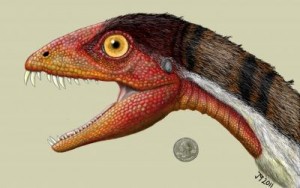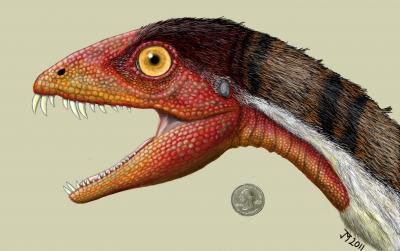ニューメキシコ州で、初期の恐竜と、後期の獣脚類の間に位置する化石が見つかりました。これまであまり見つけられていなかった時期の化石です。
Scientists discover a new species of dinosaur, bridging a gap in the dinosaur family tree
A team of scientists led by the Smithsonian Institution has discovered a fossilized dinosaur skull and neck vertebrae that not only reveal a new species, but also an evolutionary link between two groups of dinosaurs. The new species, Daemonosaurus chauliodus, was discovered at Ghost Ranch, N.M. The team's findings are published in the Proceedings of the Royal Society B, Wednesday, April 13.

初期の恐竜といえば、南米からこのところ相次いで見つかっていました(
最初期の肉食恐竜を発見)。しかし、一方で、それらおよそ2億3000万年前(三畳紀中期)から、恐竜が反映する中生代に入るまでの化石記録は、あまり見つかっていなかったそうです。
今回、Daemonosaurus chauliodusと名づけられた獣脚類の発見で、そのミッシングリンクの一環が埋められると期待されています。
The oldest theropod dinosaurs are known from the Late Carnian of Argentina. However, the evolutionary diversification of this group after its initial radiation but prior to the Triassic–Jurassic boundary is still poorly understood because of a sparse fossil record near that boundary. Here, we report on a new basal theropod, Daemonosaurus chauliodus gen. et sp. nov., from the latest Triassic ‘siltstone member’ of the Chinle Formation of the Coelophysis Quarry at Ghost Ranch, New Mexico. Based on a comprehensive phylogenetic analysis, Daemonosaurus is more closely related to coeval neotheropods (e.g. Coelophysis bauri) than to Herrerasauridae and Eoraptor. The skeletal structure of Daemonosaurus and the recently discovered Tawa bridge a morphological gap between Eoraptor and Herrerasauridae on one hand and neotheropods on the other, providing additional support for the theropod affinities of both Eoraptor and Herrerasauridae and demonstrating that lineages from the initial radiation of Dinosauria persisted until the end of the Triassic. Various features of the skull of Daemonosaurus, including the procumbent dentary and premaxillary teeth and greatly enlarged premaxillary and anterior maxillary teeth, clearly set this taxon apart from coeval neotheropods and demonstrate unexpected disparity in cranial shape among theropod dinosaurs just prior to the end of the Triassic.(Sues, H.-D., Nesbitt, S. J., Berman, D. S., and A. C., Henrici. 2011. A late-surviving basal theropod dinosaur from the latest Triassic of North America. Proceedings of the Royal Society B. doi:10.1098/rspb.2011.0410)
4/15追記:ナショナルグラフィックに日本語の解説記事があがっていたので、紹介します。
進化の空白を埋める新種の肉食恐竜
初期の肉食恐竜類とティラノサウルス・レックスのような進化した恐竜との間の空白を埋める新たな恐竜が発見された。
ニューメキシコ州ゴーストランチで化石が見つかったこの原始的な恐竜は、約2億500万年前に生息していた。体高は大型犬ほどで、頭骨の形が非常に変わっていると、論文の共著者でワシントンD.C.にある国立自然史博物館の古脊椎動物学者ハンス・ディーター・スーズ氏は説明する。「前頭部は厚みがあって短かく、大きな前歯がある。このような頭骨の肉食恐竜がこれほど古い時代に出てくるとは、まったく予想していなかった」。
これらの特徴から、発見された恐竜にはギリシャ語で「出っ歯の悪霊」を意味するダエモノサウルス・カウリオドゥス(Daemonosaurus chauliodus)という学名が付けられた。
 初期の恐竜といえば、南米からこのところ相次いで見つかっていました(最初期の肉食恐竜を発見)。しかし、一方で、それらおよそ2億3000万年前(三畳紀中期)から、恐竜が反映する中生代に入るまでの化石記録は、あまり見つかっていなかったそうです。
今回、Daemonosaurus chauliodusと名づけられた獣脚類の発見で、そのミッシングリンクの一環が埋められると期待されています。
初期の恐竜といえば、南米からこのところ相次いで見つかっていました(最初期の肉食恐竜を発見)。しかし、一方で、それらおよそ2億3000万年前(三畳紀中期)から、恐竜が反映する中生代に入るまでの化石記録は、あまり見つかっていなかったそうです。
今回、Daemonosaurus chauliodusと名づけられた獣脚類の発見で、そのミッシングリンクの一環が埋められると期待されています。



